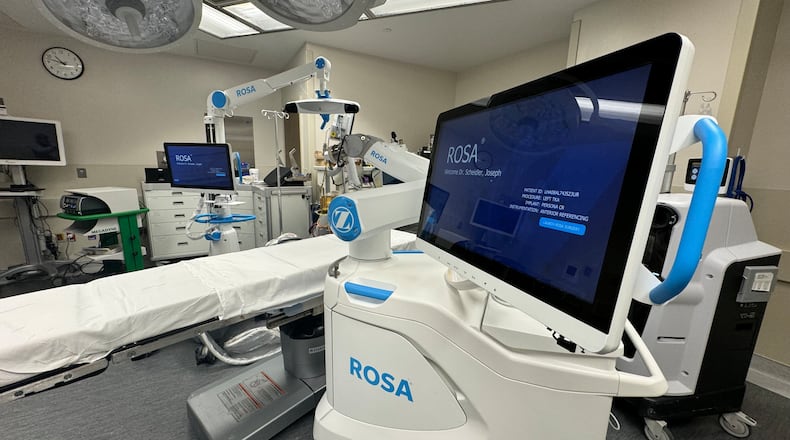But before then, orthopedic surgeon Dr. Joseph Scheidler had been an early adopter of using robots to assist with knee replacement procedures.
“Robotic surgery has been around a while, but it’s just gained momentum in the last five or so years,” said Scheidler, who was trained to use robots as a tool in the mid-to-late-2000s. They were used for selective partial knee replacement.
Credit: Michael D. Pitman
Credit: Michael D. Pitman
Today, he’s using it in all of his knee replacements, and the technology is advancing to the point where it will soon be common to see robotic-assisted surgeries for other joint replacements.
There are a number of types of robotic tools on the market, and Scheidler said he prefers the Rosa system, saying it incorporates the latest technology. They also have the Maco system that others use, but like all technology, it’s what the doctors are most comfortable with.
The American College of Surgeons cites the overall use of robotic-assisted surgery has grown over the past 25 years. The organization reported earlier this year that Intuitive Surgical, a market leader in robotic surgery systems, said more than 12 million robotic surgery procedures have been performed and more than 60,000 surgeons around the world have been trained on its da Vinci Systems.
Robot-aided surgeries allow surgeons to be even more precise in their cuts and angles and degrees of cuts in order to fit the replacement part, said Scheidler.
“It allows us to use less instrumentation in and around the bone,” he said, adding that being able to have even more precise cuts decreases risks for the patients, such as less pain and less of a likelihood for a negative reaction, such as blood clots or pulmonary emboli.
“It really is a verification,” Scheidler said, adding that they can use the robot to verify and adjust over once he, or another surgeon, is performing the replacement procedure “so we can make small adjustments in our cuts that over the course of the lifetime of the knee will make a difference in how long it lasts, what the wear rates are and what the fit is for that particular patient’s anatomy.”
Credit: Michael D. Pitman
Credit: Michael D. Pitman
Reactions to the use of a robotic system vary, from patients eager for the use of the latest technological tool to apprehension because it’s “a robot.” But Scheidler, and others, emphasize it’s a tool just like the other instruments used.
“I’m doing the operation. I’m in control of the operation. I’m in control of the robotic portion of the operation,” he said. “It’s another tool that we use to ensure accuracy and make it fit better. It allows us to custom contour our replacement to everybody.”
Nationwide, Scheidler said there are about 30% to 35% of surgeries performed are done by a robotic tool, but outside the cost to the hospital ― the investment runs in the millions of dollars ― “there’s no reason not to use it” if it’s available.
However, not many community hospitals have access to robots to assist in surgeries as Kettering Health Hamilton.
“We’re on the cutting edge of the best technology available to help patients, and it’s all in my mind geared toward patient care,” Scheidler said. “It’s exciting for me. I think it’s a really good tool, but it’s a tool and I think that’s the misunderstanding of the robot. It’s not the thing doing the operation. We’re not the Jetsons.”
While it’s used on knee replacements, the Rosa system can be used on hips but there are still advancements needed before it’s used 100% of the time. “But it’s coming,” he said.
The advancements are not there yet for shoulder replacements, he said, as well as ankles.
“Our goal is always the best outcomes for patient care,” Scheidler said. “Individually, we take and select people to have procedures. The robotic surgery allows us to more customize the cuts and the procedures for their specific anatomy.”
Credit: Michael D. Pitman
Credit: Michael D. Pitman
About the Author




